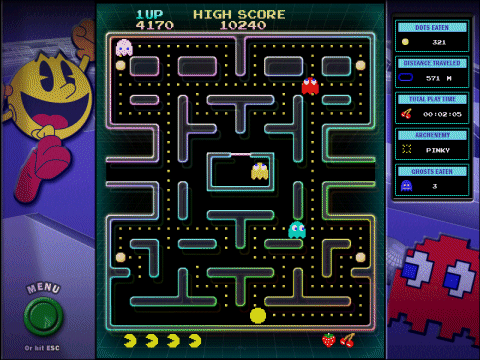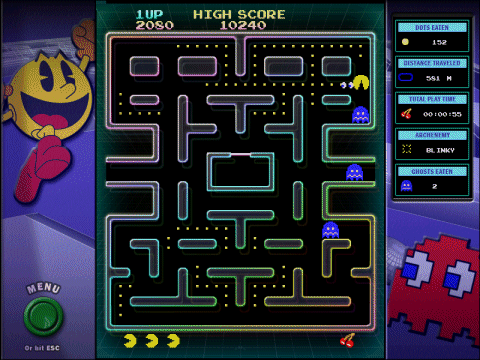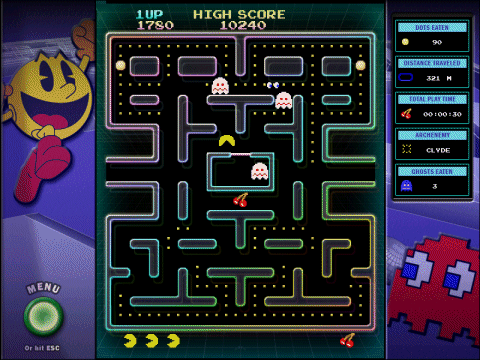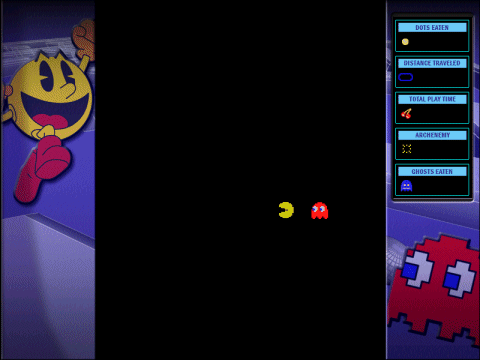| Author: | |
| Website: | |
| Page title: | |
| URL: | |
| Published: | |
| Last revised: | |
| Accessed: |
| Year: | 1980 |
| Original platform: | Arcade machine, game console |
| Brief description: | Maze game |
| Number of players: | One or two |
| Developers/contributors: | Namco |
Pac-Man is one of the most successful video games of all time. The game was created over a period of about a year by a team of developers at Namco led by Tōru Iwatani, who at the time was in his late twenties. Namco were looking for a game that would appeal to a wide audience. The most popular arcade games of the day were "shoot 'em up" type games such as Taito Corporation's Space Invaders or Atari's Asteroids that appealed mostly to young males.
Iwatani set about searching for themes that might also appeal to a female audience. In so doing he explored ideas based on fashion, romance, and (for reasons best known to himself) eating. According to Iwatani, inspiration arrived one day when he was having pizza for lunch and looked at the shape formed by a pizza with one slice removed. The missing slice looked to Iwatani like an open mouth, and apparently gave him the idea for a character that traversed a maze eating everything in its path.

This full version of Pac-Man can be downloaded free of charge from Jenkat Games
(http://www.jenkatgames.com/free/PAC-MAN)
The origins of the name Pac-Man are not entirely clear. On the one hand, Iwatani claims that the name derives from the expression "pakku pakku" which is a Japanese slang term used to describe the sound of the mouth opening and closing. On the other hand, when the game was first released in Japan it was in fact called Puck-Man, a name apparently based on the fact that the central character has a shape similar to an ice hockey puck.
With the need to appeal to a female audience still in mind, Iwatani had decided to provide some "cute" protagonists for the ever-hungry pizza-shaped character we know today as Pac-Man. These protagonists take the form of four cartoon ghosts that chase Pac-Man around the maze and attempt to catch him.
When the game was first released in Japan, the reception was initially somewhat muted. As predicted, the game did appeal to a wider audience, but did not immediately achieve the kind of popularity enjoyed by Space Invaders or Asteroids. When the game was released in the United States, however, it was a very different story. Namco licensed the game for distribution in the USA to the Midway division of Chicago-based Bally Manufacturing (the same company to which Taito Corporation had licensed Space invaders).
As with previous games, Midway produced both upright cabinet and cocktail table versions of the game. They decided to change the name of the game from Puck-Man to Pac-Man, apparently due to concerns that the original name could too easily be changed into something unsavoury. I can't imagine what they had in mind.
Like other popular video arcade games of its time, Pac-Man was easy to play but difficult to master. The game as originally implemented has two hundred and fifty-six levels. The original design allowed for the game to "roll over" at the final level, taking the player back to the first level and theoretically allowing the game to be played indefinitely.
In practice, a software bug causes the screen display to become corrupted once the player reaches the last level, making further progress impossible. Only a relatively small number of people can claim to have actually completed all of the playable levels. The first to go on record was Billy Mitchell of Hollywood in Florida, USA. Mitchell achieved this feat in July 1999, taking approximately six hours and reportedly achieving a score of over three million points (3,333,360 to be exact).
Game play is relatively simple, with the movement of the Pac-Man character being controlled by the player. On the arcade version and most console versions, Pac-Man is moved left, right, up, or down using a four-way joystick. Versions written for personal computers required the player to control the character using the keyboard. Pac-Man must navigate the maze, eating the evenly-spaced circular pellets distributed throughout the maze.
According to most sources, there are two hundred and forty pellets on the board in total, each worth ten points. The four ghosts are meanwhile trying to catch Pac-man. If Pac-Man is caught by a ghost, the player loses one of their three lives. If all three lives are lost, the game is over. There are also four "power pellets" on the board (worth fifty points each) which, when consumed by Pac-Man, cause the ghosts to change colour for a short time, during which they too can be eaten.

When Pac-Man consumes a power pellet, the ghosts turn blue and can be eaten
Immediately after Pac-Man consumes a power pellet, the ghosts all turn blue and change direction. If Pac-Man manages to catch a ghost, only the ghost's eyes remain. These can be seen scurrying back to the ghost's original position in the middle of the screen, where the ghost is returned to its normal state. The player gets two-hundred points for eating a single ghost, four hundred points for two in succession, eight hundred points for three in succession, and sixteen hundred points for eating all four ghosts in one go.
The power pellets are only effective for a short time, after which the ghosts become invulnerable once more. Just before they change back to their normal state, the ghosts "flash", with their colour alternating between blue and white. The length of time for which the power pellets affect the ghosts is reduced with each new level, until they eventually have no effect at all.

Just before the ghosts revert to normal, they flash blue and white
Once all of the pellets have been consumed, the level is over and the next level may begin. In between some of the levels there is a short "interlude" during which a brief animation of some description can be seen, presumably to give the player a break. During gameplay, a piece of fruit or some other object will appear in the maze from time to time. Eating one of these objects earns the player far more points than the standard pellets, although it usually involves making a detour, which in turn increases the chances of being caught by a ghost.
Different kinds of object (they are mostly fruit) generate different numbers of points. At the bottom end of the scale, a cherry is worth two hundred points. The most valuable object is a key, which is worth five thousand points. On achieving ten thousand points, the player is usually awarded a single bonus life.

A brief animation is shown during a short interlude between some of the levels
The behaviour of the ghosts, while seemingly random, is in fact deterministic (i.e. it follows a pre-programmed pattern). According to Tōru Iwatani, each ghost has been programmed to behave in a certain way using a different algorithm. The red ghost (known in the US version of the game as "Blinky") is programmed to chase Pac-Man. Both the pink ghost ("Pinky") and the pale blue ghost ("Inky") try to position themselves ahead of Pac-Man, although they don't behave exactly alike.
The behaviour of the orange ghost ("Clyde") is supposed to be random, although analysis has reportedly shown that it tends to follow Pac-Man most of the time. All of the ghosts will occasionally exhibit what appear to be uncharacteristic behaviours, but there is still an underlying pattern. As players gain experience, they can learn to predict the behaviour of the ghosts and use this knowledge to their advantage.
Contrary to Iwatani's initial assumption that Pac-Man would not be particularly successful outside of Japan, the game became a world-wide phenomenon and was played by tens of millions of people. It was the highest grossing game of its time, both in terms of arcade hardware sold and the revenue generated by arcade machines. The game also had an enormous impact in terms of popular culture, spawning merchandise that included everything from Pac-Man T-shirts, lunch boxes and books to Pac-Man air-fresheners and breakfast cereals.
There were countless publications dealing with strategies for playing the game. Even today, most people are familiar with the yellow pizza-shaped character. The game inspired an animated TV series produced by Hannah-Barbara that ran on the ABC television network in the USA during 1982 and 1983, and was even the subject of a hit song called "Pac-Man Fever" (from the album of the same name) written and performed by US pop duo Buckner and Garcia. The song reached number nine in the US Billboard Hot 100 chart during 1981.
Thanks to its phenomenal success, Pac-Man clones, spin-offs and re-vamped versions of the original game inevitably followed, many of which were not authorised by Namco. Perhaps one of the best known, and by far the most successful, was Ms. Pac-Man. This unauthorised Pac-Man spin-off was created by the General Computer Corporation in 1981 and sold to Midway Manufacturing.
The idea was presumably to cash in on the fact that the original Pac-Man game appealed to a female audience as well as to a male audience. A bow was added to the top of Pac-Man's head. The character was also given an eye, and a mole, presumably to reinforce the fact that the character was a female.
Other enhancements included new maze layouts, new music, and new colour schemes. Midway transferred the rights for Ms. Pac-Man to Namco in 1982, apparently to head off a threatened law suit. They continued to make unauthorised sequels, however, which is probably why Namco later dropped Midway as its US partner in favour of Atari.
The game was also ported (and for that matter continues to be ported) to just about every platform imaginable, including game consoles, personal computers and mobile devices. One of the very first ports (and one of the most infamous) was created by Atari for their Atari 2600 game console and released in 1982.
Development of the game was assigned to Atari programmer Tod Frye, who faced problems from the very start due to the relatively short time frame allowed for development by Atari's management, and the fact that the target game cartridges had far less memory than the original arcade game hardware. The Atari 2600's MOS 6507 microprocessor was also far slower than the Zilog Z80 microprocessor used in the arcade version.
In the end, so many compromises had to be made that the Atari version of Pac-Man was significantly different in appearance to the original. In addition, in order to conserve memory, the four ghost characters were redrawn in alternating frames, creating a flickering effect on screen that many players found disconcerting.
The game sold five million copies, and was the best-selling Atari game up to that time. This initial success was accompanied by an increase in sales of the Atari 2600 game console itself. Unfortunately, Atari had greatly overestimated demand, producing a total of twelve million game cartridges. This meant that they were left with five million cartridges unsold.
To make matters worse, many copies of the game were returned to sales outlets by customers who were unhappy that the game was so different from the original arcade version. Later ports created by Atari for their other consoles and personal computers were far better, but the damage to Atari's reputation had already been done.
The episode marked a turning point in Atari's fortunes, which went into decline as consumer confidence in the company faded. It is also often cited as a contributing factor in the so-called "video game crash" of 1983.
The initial success of Atari's home console version of Pac-Man led to a number of retailers, some of whom had never previously stocked video games, buying in large stocks of game cartridges in the hope of cashing in on the apparent sudden increase in the demand for home video games. Things reached a stage where even drugstores and filling stations were offering game cartridges for sale. The end result was a glut of video games on the market, many of which were poor quality imitations or bootleg copies of the popular titles of the time.
Despite these events, Pac-Man itself has continued to prosper and can still be found today on numerous platforms. The game introduced a number of new concepts to the world of video gaming, and its influence can be seen in many of the successful games that followed. Its broad appeal can be attributed to a number of characteristics. It was easy to play, featured characters that were both colourful and memorable, and contained no overt violence.
There was also an underlying humour to the game, epitomised by the animations that appeared between levels. These animations typically showed Pac-Man being chased by, or chasing, one or more ghosts across the screen. In short, it was a fun game to play.